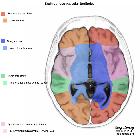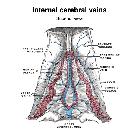cerebral veins

The cerebral veins drain the brain parenchyma and are located in the subarachnoid space. They pierce the meninges and drain further into the cranial venous sinuses.
The cerebral veins lack muscular tissue and valves. The cerebral venous system can be divided into:
- superficial (cortical) cerebral veins
- deep (subependymal) cerebral veins
Superficial venous system
The superficial venous system is comprised of the sagittal sinuses and cortical veins. The cortical veins course along the cortical sulci, drain the cortex and some of the adjacent white matter. There are numerous cortical veins, and most of them are unnamed; however, the large cortical veins can be identified according to their locations, the cortical venous system can be subdivided into superior, middle and inferior groups. Important veins of the superficial cerebral venous system are:
- superficial middle cerebral vein (Sylvian vein)
- superior anastomotic vein (of Trolard)
- inferior anastomotic vein (of Labbé)
Deep venous system
The deep venous system consists of the lateral sinuses, sigmoid sinuses, straight sinus and draining deep cerebral veins (subependymal and medullary veins).
- medullary veins: they are numerous and originate 1-2 cm below cortical gray matter and pass through deep medullary white matter and drain into subependymal veins. The medullary veins are arranged in a wedge-shaped manner and distributed at a right angle to subependymal veins.
- subependymal veins: they receive medullary veins and aggregate into greater tributaries, mainly into septal veins, thalamostriate veins, internal cerebral veins, basal vein of Rosenthal and vein of Galen.
Both of these systems mostly drain into internal jugular veins. Generally, venous blood drains into the nearest venous sinus or, in the case of blood draining from the deepest structures, into deep veins.
Siehe auch:

 Assoziationen und Differentialdiagnosen zu Venen des Gehirns:
Assoziationen und Differentialdiagnosen zu Venen des Gehirns:



